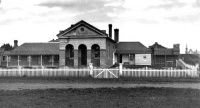Orange Court House
From The Orange Wiki
The first public building erected in Orange was a watch-house (or police station) for which work tenders were called in February 1848; it was a slab and bark building on the site of the present Court House.
A new Court House was built in 1851 and early church services were held there when Orange had no Anglican Church or Minister. Similarly when Orange was proclaimed a municipality on 9 January 1860, the first meeting of the Council was held at the Court House. Council continued to meet in the Court House until the Orange Town Hall was constructed in 1883. (Sheridan, p. 6).
The tender of Kennard and Snow [who were also undertakers] was accepted in October 1860 for a new Court House and the work was completed in December 1862, at a cost of ₤1,786 10/-. The sandstone used in it [presumably the fence pillars] came from William. Tom's quarry at Cornish Town. The stonemason was a Mr Connor who made the foundation stone for the Orange Town Hall and Court House, and fashioned the stonework on other public buildings in the town.
"Ben Hall was held in Orange lockup during April and May 1862 when he was remanded from Forbes to appear in the Orange Court for the robbery of a drayman near Forbes. This is... one of the stories which historians have associated as the mounting police persecution which caused Ben Hall to turn bushranger.
Hall was arrested at Wowringragong racetrack, Forbes, by Inspector Pottinger and was later remanded to Orange Quarter Sessions to face a charge of highway robbery. Hall spent a month in the 'logs' and was acquitted because the main witness, Ferguson, could not positively identify Hall as part of Gardiner's gang. Later evidence showed that Hall was involved and he actually walked out of the courtroom with James Ferguson".
(Passey, p. 68).
"[Apart from Ben Hall] the other famous bushranger to spend time in the cells at Orange was John Dunn, who was captured at Macquarie Marshes near Quambone, north of Dubbo. During his capture, the young bushranger was severely wounded. He was kept at Orange overnight as he was being transferred from Dubbo to Bathurst. He was extremely ill on his arrival at Orange. Dunn was later hanged at Darlinghurst gaol in Sydney, on March 19th, 1866". (Passey, p. 68).
[Photo: The Orange Court House as it looked before 1881. The first Court House was established in 1849. This Court House was built in 1862, the same year that Ben Hall had answered charges relating to robbery under arms. This building was demolished 19 years later when the present court house was built". (Passey, p. 67).
Third (Barnet) courthouse:
"A Mr. Connor was the stonemason who made the foundation stone for the Orange Town Hall and Court House, and fashioned the stonework on other public buildings in the town". (Voices, CWD, 8 May 1984).
"Bricks for the Court House [by 1888] came from Samuel Frost's brickworks". (Voices, CWD, 11 December 1984).
According to an article in the Central Western Daily on 7 August 1951 "The stone and iron fence of the courthouse was erected by Mr. Venables. Much of the work was done by a young employee, George Rauchle.
The 3rd Court House was officially opened by the Honourable H.E. Cohen, the Minister for Justice, on May 10, 1883.
- Central Western Daily 7 August 1951

